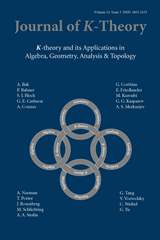Crossref Citations
This article has been cited by the following publications. This list is generated based on data provided by Crossref.
Seidel, Paul
2013.
Lagrangian homology spheres in (Am) Milnor fibres via ℂ∗–equivariantA∞–modules.
Geometry & Topology,
Vol. 16,
Issue. 4,
p.
2343.
Seidel, Paul
2015.
Picard–Lefschetz theory and dilating ℂ*-actions.
Journal of Topology,
Vol. 8,
Issue. 4,
p.
1167.
Cotti, Giordano
and
Varchenko, Alexander
2021.
Integrability, Quantization, and Geometry.
Vol. 103.1,
Issue. ,
p.
101.
Kuznetsov, Alexander
and
Smirnov, Maxim
2021.
Residual categories for (co)adjoint Grassmannians in classical types.
Compositio Mathematica,
Vol. 157,
Issue. 6,
p.
1172.
Fonarev, Anton Vyacheslavovich
2024.
Derived categories of Grassmannians: a survey.
Успехи математических наук,
Vol. 79,
Issue. 5(479),
p.
61.


 , where the
, where the 